

XSPC RS360 Radiator Pressure Drop Flow Testing
Introduction
Welcome to my pressure drop testing of the XSPC RS360 radiator. I would like to give special thanks to Paul from XSPC for yet another great product to review, the products I have tested have all surprised me in the amount of attention XSPC gives towards top performance at great prices. They really put 100% into making products that perform well!
With this review I will focus on the pressure drop and flow characteristics for this radiator.
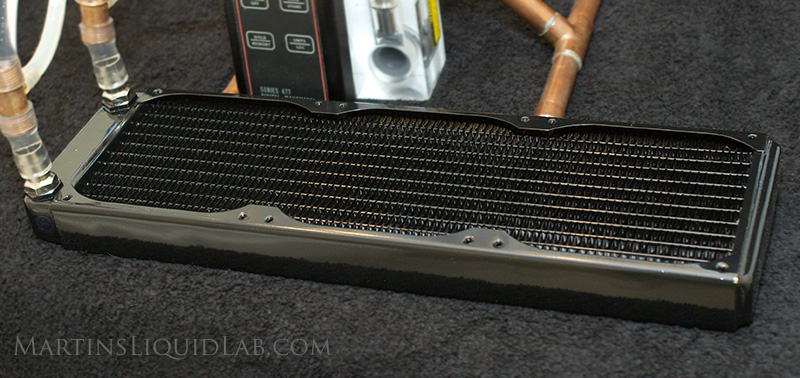
Radiator Characteristics
The radiator is a typical brass chamber and tube construction with copper fin similar in fin density and size of the Swiftech MCR quiet series or the HWlabs BIP series. I found that it had the following characteristics:- Copper Fins (13 folds per inch)
- Brass Chambers
- G1/4 barb ports to accept a wide variety of G1/4 fittings
- Black Gloss paint finish
- 4.75" (120mm) width
- 15-1/2" (391mm) height
- 1.35" (35.5mm) thickness
- 1lb 9.0 ounces (without barbs) weight
- ROHS compliant
Hydraulics and Pressure Drop Testing
The most scientific way to determine a blocks hydraulic resistance is to test pressure drop. Pressure drop is a measurement of pressure loss across a radiator that varies with flow rate. This is basically a measurement of energy loss, and directly influences how much flow rate you will have.Equipment:
- Dwyer Digital Manometer 477 Mark V - Accuracy .5% of Full Scale. Range 0-20.00 PSI range, Resolution .01 PSI
- King Instruments 7520 Series 0-5GPM, 250mm scale - Accuracy 2% of Full Scale. Range 0-5GPM, Resolution .1 GPM (can be interpolated to .02GPM)
- Water Source - Household water pressure - 50PSI at >5GPM - Because flow rate readings are instantaneous, household tap water and water pressure are a good and powerful source for pressure drop testing.
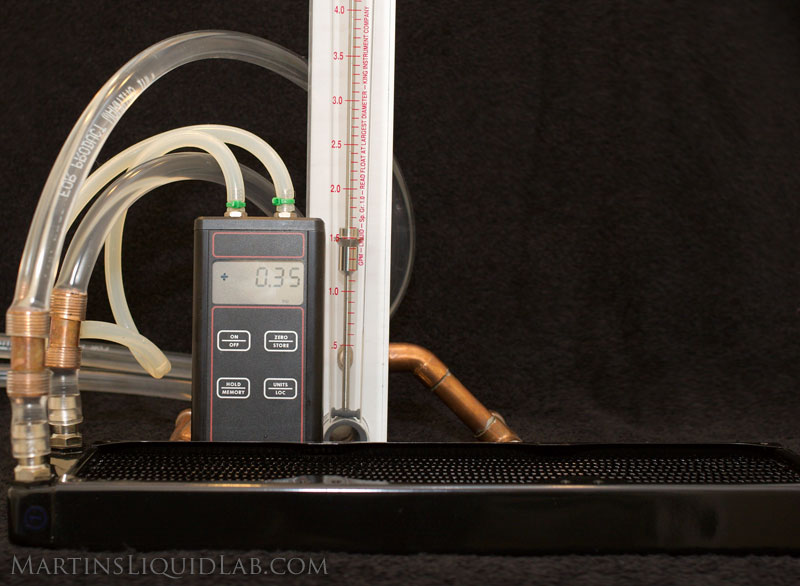
And my results are as follows, the pressure drop results are very very good!
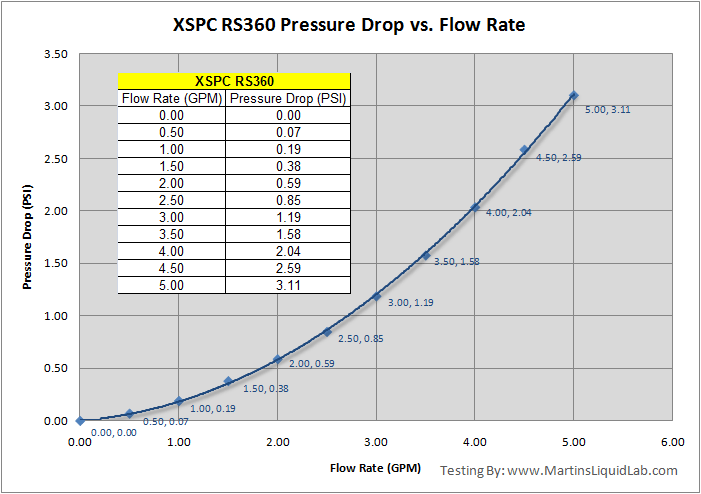
And if you're not familiar with what this means, I'm providing a relative chart below comparing a few other published and tested curves to the acquired results. Keep in mind these comparison curves were based on other testing facilities, so there could be some error in different test beds but pressure drop is generally a fairly repeatable test if good equipment is used. The XSPC RS360 is right near the bottom of the group, it is the best flowing of the single row tube style radiators, very nice. Upon careful inspection of the interior from what I can see, these radiators flare the tube ends more than others and this reduces entrances losses which helps lower pressure drop, very nice!
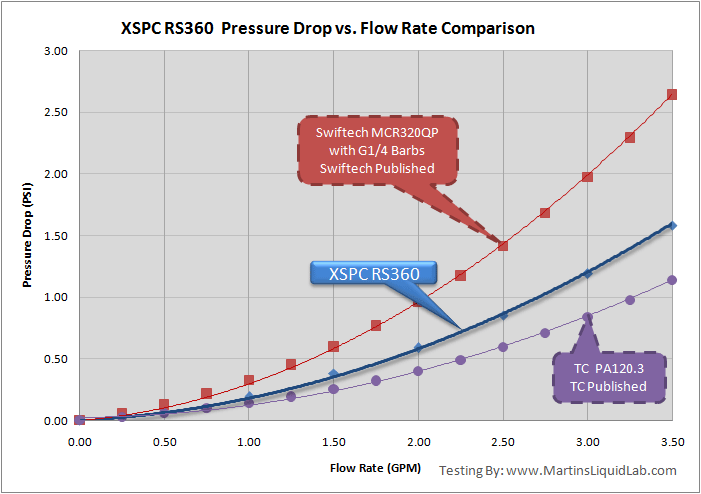
This will allow you to maximize your system flow rates for excellent thermal efficiency in your water blocks. This is yet another great product from XSPC with bottom line performance.
At watercoolingshop.com the prices were including VAT as of 4-10-2008
XSPC RS360 = £28.99
Thermochill A120.3 = £55.99
HWlabs BI GTS360 = £35.99
So in terms of cost using the black RS360, you can save 19% over a GTS 240 radiator and 48% less than a Thermochill PA120.3, that's a great price!

Cost Comparison
So another important consideration with most people is cost. For a fair cost comparison, I chose the good folks at watercoolingshop.com since they carry both the XSPC and Thermochill PA series radiators.At watercoolingshop.com the prices were including VAT as of 4-10-2008
XSPC RS360 = £28.99
Thermochill A120.3 = £55.99
HWlabs BI GTS360 = £35.99
So in terms of cost using the black RS360, you can save 19% over a GTS 240 radiator and 48% less than a Thermochill PA120.3, that's a great price!
Thermal Testing
I did my normal radiator testing (See Thermal Testing Specification on this page) on this radiator using my crystalfontz to log six air inlet, four air outlet, a water inlet, and a water outlet over 10 1-hour tests until water delta equilibrium was reached. Each test was run using a different fan and RPM setting to give you a nice broad range of performance figures. Flow rate was fixed at 1.5 GPM and heat load was provided by modified aquarium water heaters plus an assumed 15 watts for a Laing DDC2 pump for a total of approximately 300 watts and again at 600 watts. Each fan was tested the same using a pull configuration without shroud.The following results were obtained:


First are my tabular results which includes additional data like the air in and air out, etc. This is fairly typical of a slim 21mm thickness lower density radiator optimized for low speed fans.
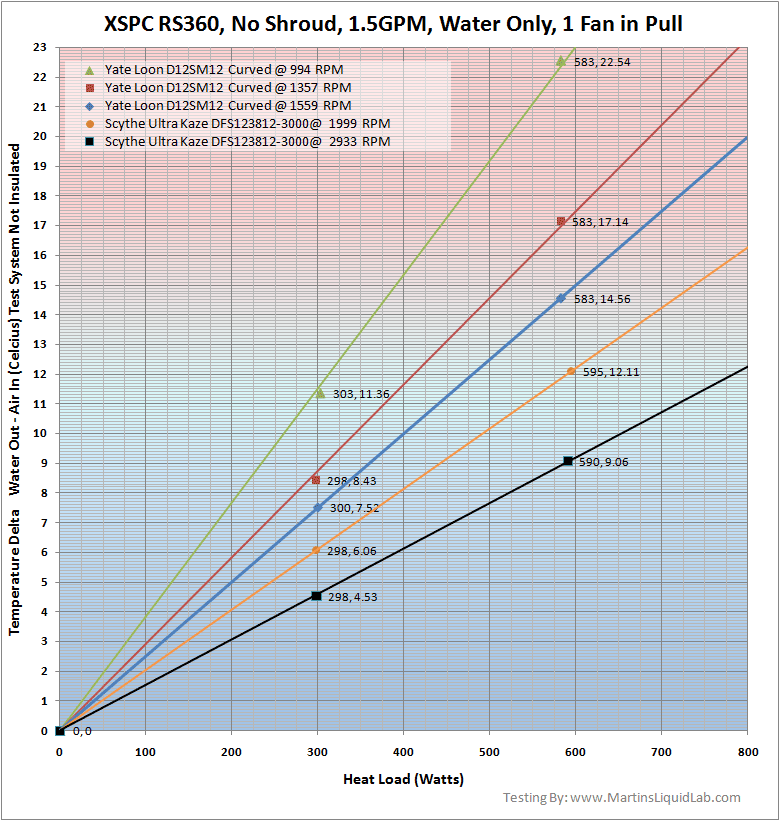
And this is the estimating chart where you can select a heat load in watts and get an estimated water temperature. For example assuming I was running a 200 watt quad core setup using Ultra Kaze fans at 2930RPM, I would get about a 4.4C delta. So if my ambient temperature was 20C, my water temperature would be around 24.4C.
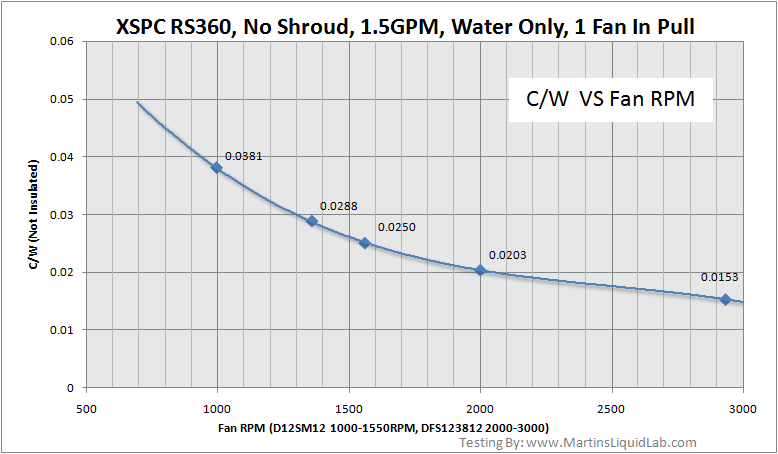
These are the c/w values plotted over the fan range, more than anything this just shows you the overall testing is following a fairly controlled trendline which is good, and c/w gains diminish as the RPM increases.
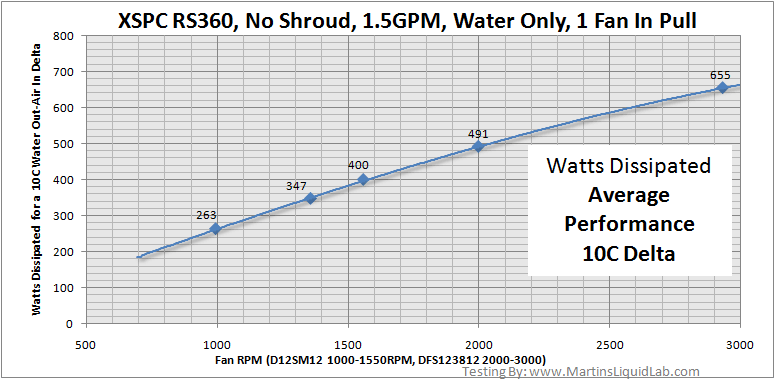
And everyone wants to know what heat dissipated is. This is what I call the 10C "Average Performance" delta where, where it's still good, but not an extreme setup where 5C deltas are desired. With this you can see that you could cool a wide range of different components depending on the fan performance and there is about a 2.5X performance gain using the 3000RPM 38mm high pressure fans vs. the undervolted 1000RPM 25mm fans.

And this is the high performance 5C delta chart where water temperatures are very cool and would provide extreme cooling performance. You can cool a very hot CPU plus GPU combo worth over 300 watts and still manage very high performance 5C deltas with strong fans.

And this is the estimating chart where you can select a heat load in watts and get an estimated water temperature. For example assuming I was running a 200 watt quad core setup using Ultra Kaze fans at 2930RPM, I would get about a 4.4C delta. So if my ambient temperature was 20C, my water temperature would be around 24.4C.
To estimate a heat load you can use the following tools:
- Extreme Outer Visions PSU calculator - Just note heat load minus the 38 watts included in the start.
- Swiftech's Conroe/Kentsfield CPU calculator - This is actual an estimator for the kit, but it also gives what I think is a more accurate heat load for the processor. Just plug in the field and it will output a heat load in watts.

These are the c/w values plotted over the fan range, more than anything this just shows you the overall testing is following a fairly controlled trendline which is good, and c/w gains diminish as the RPM increases.

And everyone wants to know what heat dissipated is. This is what I call the 10C "Average Performance" delta where, where it's still good, but not an extreme setup where 5C deltas are desired. With this you can see that you could cool a wide range of different components depending on the fan performance and there is about a 2.5X performance gain using the 3000RPM 38mm high pressure fans vs. the undervolted 1000RPM 25mm fans.

And this is the high performance 5C delta chart where water temperatures are very cool and would provide extreme cooling performance. You can cool a very hot CPU plus GPU combo worth over 300 watts and still manage very high performance 5C deltas with strong fans.
There you have it, a very low pressure drop, low cost, and well performing compact radiator that can suit many needs. Due to the low pressure drop of this radiator, I would certainly consider running two or three in the same loop if it's needed to gain the cooling capacity needs and fan preference that you are after. Use the above guides to estimate your heat loads and water temperature. If running two of the same radiator, simply take your actual heat load and cut it in half over the two radiators. My recommendation is to strive for a 5C delta if possible, but up to a 10C delta is generally considered acceptable.
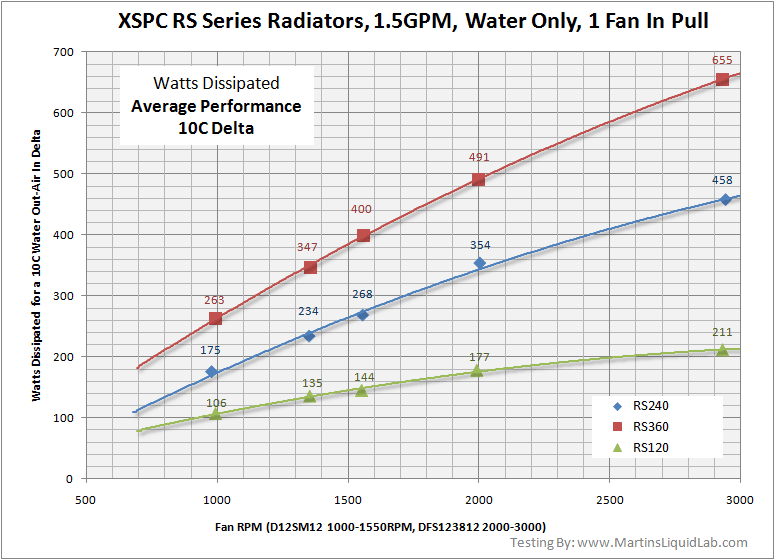
The interesting thing about this is the slightly higher efficiency of the smaller radiators sizes with slower speed fans. You might intuitively think the triple radiator would always scale to dissipate 3X the heat, but that's not the case here until you get into the higher speed fans. This could possibly be due to the heat lost in the test setup (out tubing, reservoir, etc.) and/or there is an added benefit in water turbulence in the tubes themselves that privides better heat transfer near the tubing ends. Regardless, this is a useful tool for you to consider each of the three sizes in one chart(Divide the numbers by 2 for a 5C chart). One example might be, you have a 200 watt heatload to dissipate and you're fine with a 10C delta. Per the chart, you could use an RS120 with a 2600RPM fan, or an RS240 with 1200RPM fans, or an RS360 with 800 RPM fans.
XSPC RS Series Radiator Comparison
Now that I have all three of the RS series radiators, here is a 10C delta comparison of all three.
The interesting thing about this is the slightly higher efficiency of the smaller radiators sizes with slower speed fans. You might intuitively think the triple radiator would always scale to dissipate 3X the heat, but that's not the case here until you get into the higher speed fans. This could possibly be due to the heat lost in the test setup (out tubing, reservoir, etc.) and/or there is an added benefit in water turbulence in the tubes themselves that privides better heat transfer near the tubing ends. Regardless, this is a useful tool for you to consider each of the three sizes in one chart(Divide the numbers by 2 for a 5C chart). One example might be, you have a 200 watt heatload to dissipate and you're fine with a 10C delta. Per the chart, you could use an RS120 with a 2600RPM fan, or an RS240 with 1200RPM fans, or an RS360 with 800 RPM fans.
Shroud or push/pull gains
I used the RS120 to do a whole bunch of fan orientation and shroud performance gains here. I saw some significant performance gains particularly using the 38mm fans in different orientations. Installing two 38mm fans in push pull on this radiator provided nearly a 25% gain over one fan in pull, or just one 38mm fan in push with a 30mm shroud provided a 19% gain. All of this testing and results on this page was done with a single fan in pull condition so if you double up on fans in push/pull or use a shroud, you'll see better performance than the above results.Pros
- Very low pressure drop - Great for multiple radiator and block setups.
- Compact and easy to fit in many locations, works well as a supplimental raditor for existing setups.
- Excellent price point
- Performs well, depending on the fan used can fullfill a wide variety of cooling needs.
- Responds well to the addition of shrouds or two fans in push/pull.
- Optimized for low speed fans
- M4 tapped screw holes
- G1/4 barbs
Cons
- Not as thermally efficient as the more expensive radiators, due to it's more compact size (120mm width, 21mm thickness), but with the low pressure drop you can easily install several of these in the same loop and maintain plenty of flow rate.
Where to buy
XSPC Retailers Link
